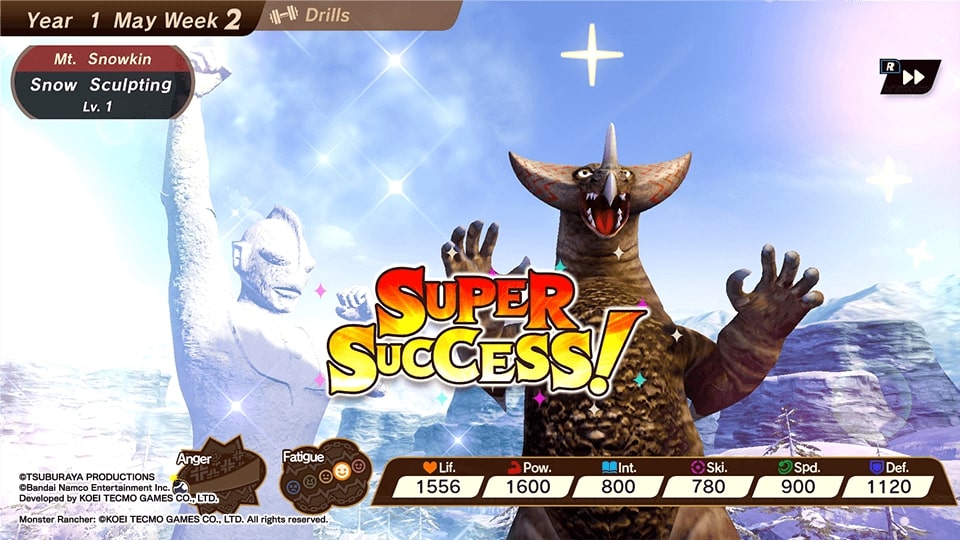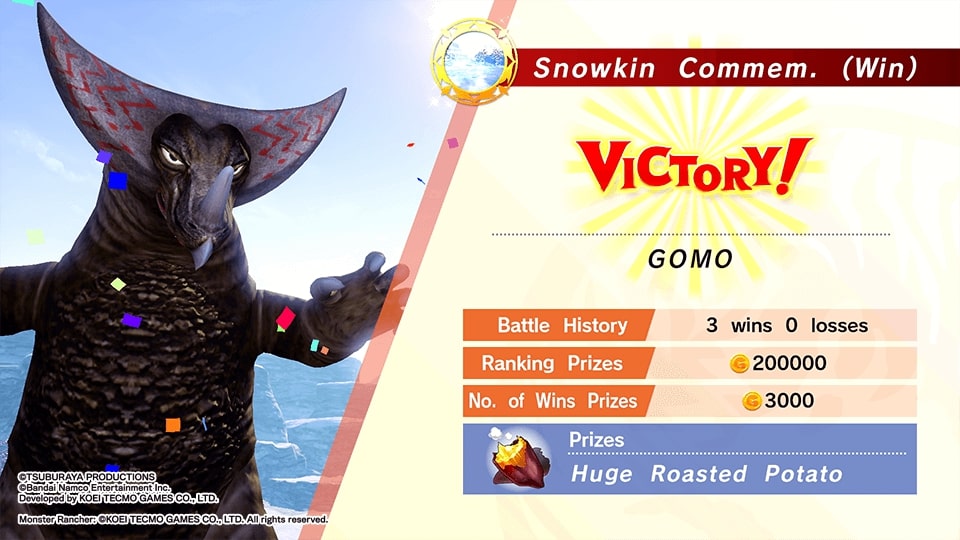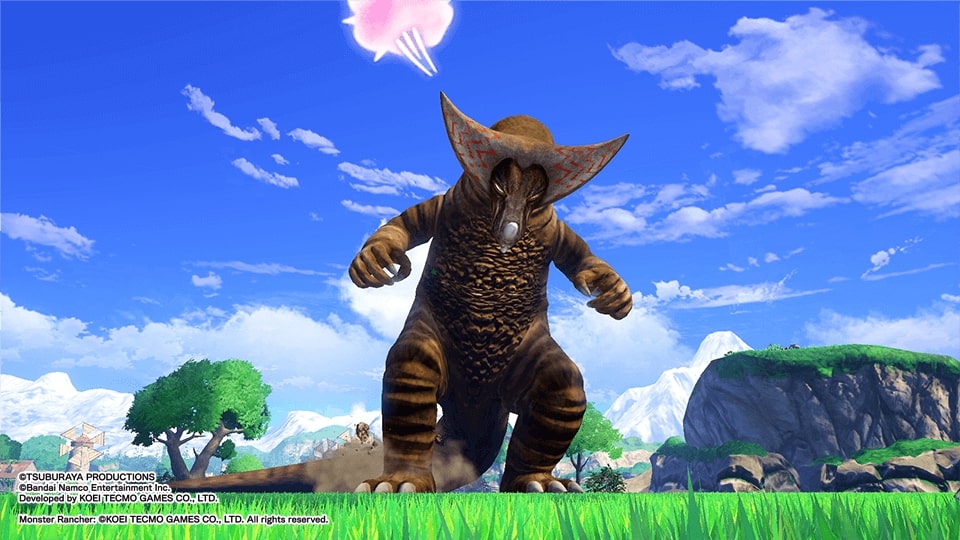The Monster Rancher series has always flown a bit under the radar. Released during the monster collection/raising RPG zeitgeist of the late 90s, Monster Rancher garnered a core audience of fans thanks to its unique focus on raising and breeding simulation and the ability to generate monsters from CDs. The series tried reinventing itself many times over the years, but once Tecmo merged with Koei, Monster Rancher fell dormant. That is, until 2021 brought a remastered double pack of the original PlayStation titles. It appears this release did well, as 2022 saw the first original entry in the series in over a decade, Ultra Kaiju Monster Rancher. Combining the classic Monster Rancher structure and gameplay with the Ultraman IP, Koei Tecmo has teamed up with Bandai Namco to give fans and newcomers alike a crossover probably no one expected. Fortunately, Ultra Kaiju Monster Rancher manages to fit that city-bus-sized kaiju foot into the shoes left by previous Monster Rancher games, for an experience that any Monster Rancher or Ultraman fan can enjoy with a bit of patience and an open mind.
Ultra Kaiju Monster Rancher starts like any classic Monster Rancher title: you generate your first monster and then take it to the ranch, where you are introduced to the calendar system, various training regimens, and how to enter and fight in tournaments. In fact, the underlying foundation of Ultra Kaiju Monster Rancher is based heavily on the template set by Monster Rancher 2. This was a wise choice, as Monster Rancher 2 is both a fan-favorite title and fairly accessible to newcomers. While later titles in the series would introduce free-roaming expeditions, random battles with wild monsters, and other traditional RPG elements, Ultra Kaiju is content to keep things simple. The game is divided into two main gameplay styles: the primarily menu-based ranch portion where you train your monster, and the tournaments where you participate in real-time battles against the monsters of other breeders.
The core gameplay loop involves training your monster week-per-week, feeding them according to their likes and dislikes, and keeping an eye on their fatigue to avoid shortening their lifespan while optimizing their various stats. Training can be further augmented by sending your monster on errantries, which are trips to another rancher’s farm. There, they train with that monster for an entire month to quickly raise certain stats and learn new combat skills. You can also send your monster on adventures (unlocked after raising your breeder level), where you direct them along maze-like environments to find items before they run out of stamina. Some of these items must be found in order to unlock new monster types, so there is always a reason to embark on adventures.
These options achieve a nice balance, as you have to weigh your desire to learn new skills and gain new items against the opportunity to fine-tune your monster’s stats. I often found myself entering each month with a plan, making sure my monster had plenty of rest while managing training sessions and trips away from the ranch while keeping an eye on the calendar for the next official tournament.
Once your monster appears battle ready, you can enter them into various tournaments in order to increase their power ranking and your breeder rank. Battles are real time and last only 60 seconds. You have (mostly) direct control over the monster. You can move your monster backwards and forwards, and your distance from the opposing monster determines what skills you can use. Skills use a resource called Guts, which starts out full and then slowly builds back up as the battle continues. When you command your monster to attack, depending on your bond with them, they may do as you ask or appear confused, which can cost you valuable time. Whoever KOs the opponent’s monster first, or has the highest HP percentage once time is up, wins the match. Despite these simple rules, battles often feel like a subtle dance, advancing upon the opponent to get in a clean hit, or backing away to give your monster distance to gain more Guts for the next attack. As you progress through the ranks, tournaments include more and tougher opponents. Some of the later tournaments took me a few tries to master, presenting a nice challenge without being too frustrating.
Monsters will eventually need to retire, and this is where the breeding mechanics come into play. Once a monster is retired, you can no longer train them or use them for battles. However, you can fuse them with another monster to carry over some of the stats gained. Some types of monster fusions can result in rarer, more powerful monster types, and monsters can even be fused with items for stat bonuses or other effects. Since the Switch lacks a disc drive, monsters are no longer generated through CDs. Instead, they can be generated from NFC tags or from the media list carried over from Monster Rancher 1&2 DX. Unfortunately, I was unable to test the NFC generation as I didn’t have any suitable NFC tags (Amiibos will not work), but the media list works just fine. Since all the monsters here are new to the series, even if you are familiar with the media list in DX, I was always surprised by what monsters were generated in Ultra Kaiju.
I didn’t have any familiarity with Ultraman prior to playing Ultra Kaiju Monster Rancher, but as a Monster Rancher fan, I think the crossover works quite well. The presentation is on a much larger scale, with the giant monsters towering over your ranch and your assistant, Kanezo. Monsters all have that “man in a rubber suit” look characteristic of classic kaiju films, which gives each design a bit of quirky charm that I quite enjoyed, despite keeping each monster bipedal and vaguely humanoid in shape. Animations have a nice weight to them, and it’s cool to see these massive creatures stomp through the scenery and knock each other over into mountains and oceans.
There are some new mechanics introduced to the series in keeping with the kaiju theme, namely territories and the anger meter. Each training area you can visit from your ranch has a corresponding territory meter. Using a training facility slowly increases the meter, and once it is full, that area is claimed as your monster’s “territory.” Claimed territories offer increased stats when you train there, however rival wild monsters have a chance to appear at any training area each week and contest the territory. If a rival monster shows up, your monster must fend them off in order to avoid losing ownership of the training spot. This serves as a nice pace breaker and provides a good opportunity to practice and try out new moves without the pressure of needing to do well in a tournament.
Anger serves a similar function to fatigue, increasing slowly as you have your monster perform training tasks, and reducing when they rest or after they’ve let off steam in battles. If the anger meter reaches full, monsters have a fit, and can run away and ruin your training schedule, or destroy the ranch and cost you significant amounts of money in repairs. While this mechanic didn’t massively change the way I approached raising my monsters, it did drive me towards battling more frequently, and goes a long way in making the kaiju feel like big, dangerous creatures.
I did find myself missing the Monster Rancher monsters, and while a couple of kaiju-sized variants of series mascots Mocchi and Suezo can be unlocked, it just isn’t the same as playing with the classic stable of monsters like Pixie, Tiger, and Golem. For big fans of Ultraman or kaiju media in general, however, Ultra Kaiju Monster Rancher does a great job of capturing the over-the-top absurdity of the premise. Occasionally, during a rampage, Ultraman can even appear and put the smackdown on your monster! Load times are fairly quick, the user interface is snappy, and most events can be fast-forwarded or skipped entirely. There are some returning human faces from previous games in the series as well, which is a nice consolation for Monster Rancher fans missing the monsters they know and love.
But overall, the main draw of Ultra Kaiju Monster Rancher for me was the refinement of Monster Rancher 2’s systems. It’s great to see the series return and build off the foundation set by Monster Rancher 2 for a modern audience. While I miss the classic monsters, the Ultraman crossover is successful and gives Ultra Kaiju Monster Rancher a unique identity compared to the rest of the series. Most of the kinks of the classic games have been ironed out, distilling the core gameplay into a smooth and welcoming experience for newcomers and experienced ranchers alike.





